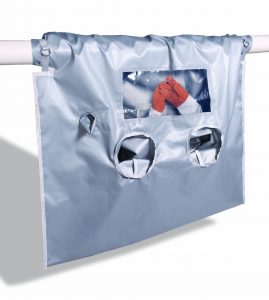
 Did you know that the Therm-Equip, Inc.® Pipe Case (high temperature glovebag) was developed in 1987 and put on the market in 1988? Before developing the Pipe Case, we were a distribution business supplying asbestos- removal contractors. In the early 1980’s, contractors contacted us regarding asbestos removal on live steam lines. At that time, there were two approved removal methods according to OSHA-full containment and glovebags. The issue with glovebags then was that OSHA had a regulation <29CFR 1910.1101(g)(2)(ii)> that restricted the existing polyethylene glovebags use to surface temperatures lower than 150 degrees F.
Did you know that the Therm-Equip, Inc.® Pipe Case (high temperature glovebag) was developed in 1987 and put on the market in 1988? Before developing the Pipe Case, we were a distribution business supplying asbestos- removal contractors. In the early 1980’s, contractors contacted us regarding asbestos removal on live steam lines. At that time, there were two approved removal methods according to OSHA-full containment and glovebags. The issue with glovebags then was that OSHA had a regulation <29CFR 1910.1101(g)(2)(ii)> that restricted the existing polyethylene glovebags use to surface temperatures lower than 150 degrees F.
The development process involved contact with contractors to determine the relevant factors important to the safety and effectiveness of a higher temperature glovebag. Existing glovebags are made from low density polyethylene, which while great for cold removal, start softening at temperatures over 150 F. Therefore, the first requirement is to make sure that all materials will withstand higher temperatures. Second, the materials must also be strong enough to hold, when hot, the ACM (Asbestos Containing Materials). Third, we changed the gloves from latex to an insulated leather in order to protect the workers’ hands, as well as resist heat and offer manual dexterity. Finally, the bags should be available in sizes to allow production to gain economy of scale.
The first Pipe Case produced in 1988 was the 700-degree F version and available only in 60×60 and 60×72 horizontal configurations. Therm-Equip, Inc. took over manufacturing in 1992 and increased the number of styles to include vertical configurations as well as models for larger pipes. Also, a lower cost 400 F and 300 F versions completed the offerings. In 1995 OSHA ruled the use of our Pipe Cases as compliant with OSHA regulations. Many large oil refineries, automobile manufacturers, and universities have placed the Pipe Case into service for abatement. Call us today to determine what will fit your situation best.
